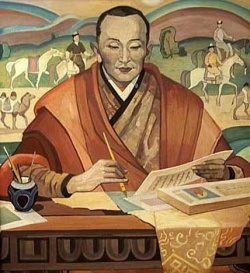Zaya Pandit
Zaya Pandit was the great missionary monk, responsible for converting many of the Mongol tribes of China and also the Kalmyks to Buddhism. He was born in 1599 into a princely Oirat family and at the age of 16 went to Lhasa in Tibet for his education. Over the next decades, he grew into an outstanding scholar and teacher. Zaya Pandita’s greatest achievement was to develop a script for the Kalmyk language and then to translate numerous texts into that language. He translated about 180 works altogether and also wrote a huge guide to Buddhism called The Clear Mirror of the Dhamma, a work still studied by Kalmyks. Such was his reputation for learning and piety that in 1640 he was able to convince the Mongol tribes to unite for their mutual benefit and to resist pressure from Russia and China. When he died in 1662 he was widely considered to be a saint.
Zaya Pandita was the fifth son of Babakhan, a minor Khoshut-Oirat prince. After Babakhan converted to Buddhism in the early 17th century, he, like many of the other Oirat princes, wished for one of his sons to enter the Buddhist clergy. In pursuit of his wish, Babakhan chose Zaya to become a bandi ("novice") monk. In 1615, Zaya journeyed to Lhasa, Tibet where he would study and practice Buddhism, including study under the guidance of the 4th Panchen Lama.
In 1638, Zaya Pandita left Tibet at the direction of the Panchen Lama to conduct missionary work among the Mongol tribes. One year later in 1640, he assisted Erdeni Batur, Khun Taiyishi of the Choros-Oirat tribe, in assembling a pan-Mongol conference between the Oirat and the Khalkha. The purpose of the conference was to encourage the formation of a united Mongolian front against potential external enemies, such as the Chinese, Manchus, and Russians and to settle all internal matters peacefully. The conference produced a code, which provided protection from foreign aggression to both the Oirat and the Khalkha and guaranteed the free movement of people throughout Mongol land.
When not engaged in diplomacy between the Oirat and the Khalkha, Zaya Pandita spread Tibetan Buddhism to the Oirats, the Khalkha and even the Kalmyks in far away Russia. In furtherance of his missionary work, Zaya Pandita composed a new alphabet, based on the traditional Mongolian alphabet, called "Clear script" (todo bichig) to transcribe the Oirat language as it is pronounced. By doing so, Zaya Pandita eliminated the ambiguities of the traditional Mongolian alphabet.
From the time Zaya Pandita developed todo bichig in 1648 until his death in 1662, he translated approximately 186 Buddhist texts from Tibetan language to the Oirat language while still serving the religious needs of the Oirat tribes in Dzungaria. His most famous work is the four-volume Clear Mirror of Teachings.
The todo bichig script is still used by Oirats in Xinjiang with slight revisions, and is taught alongside standard classical written Mongolian in that region.
